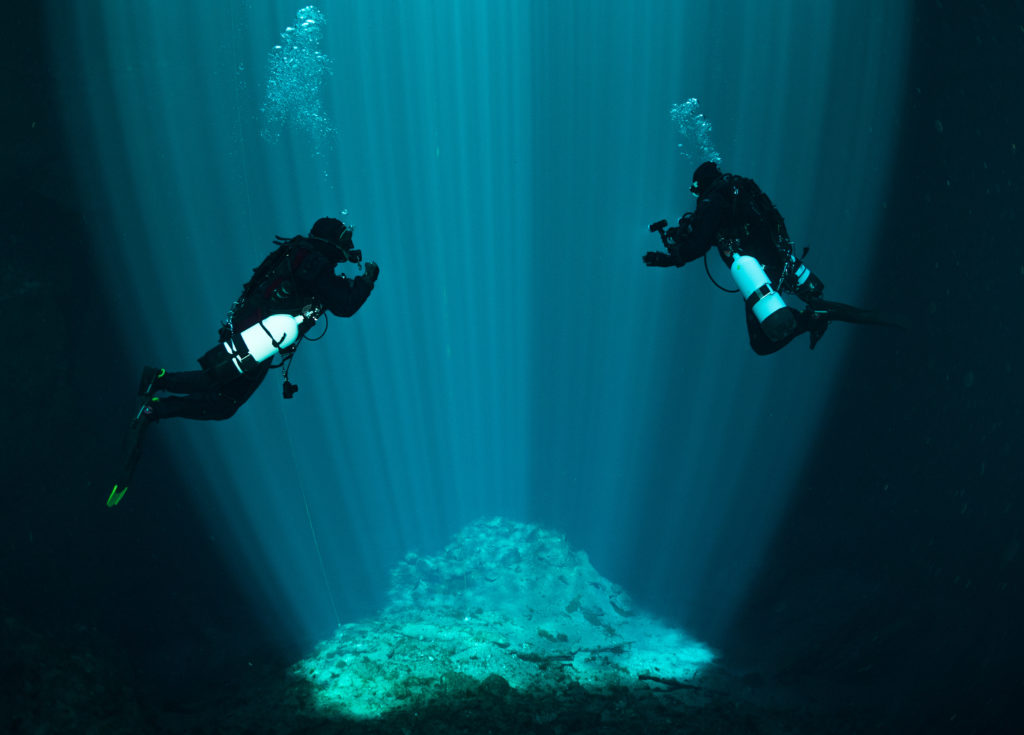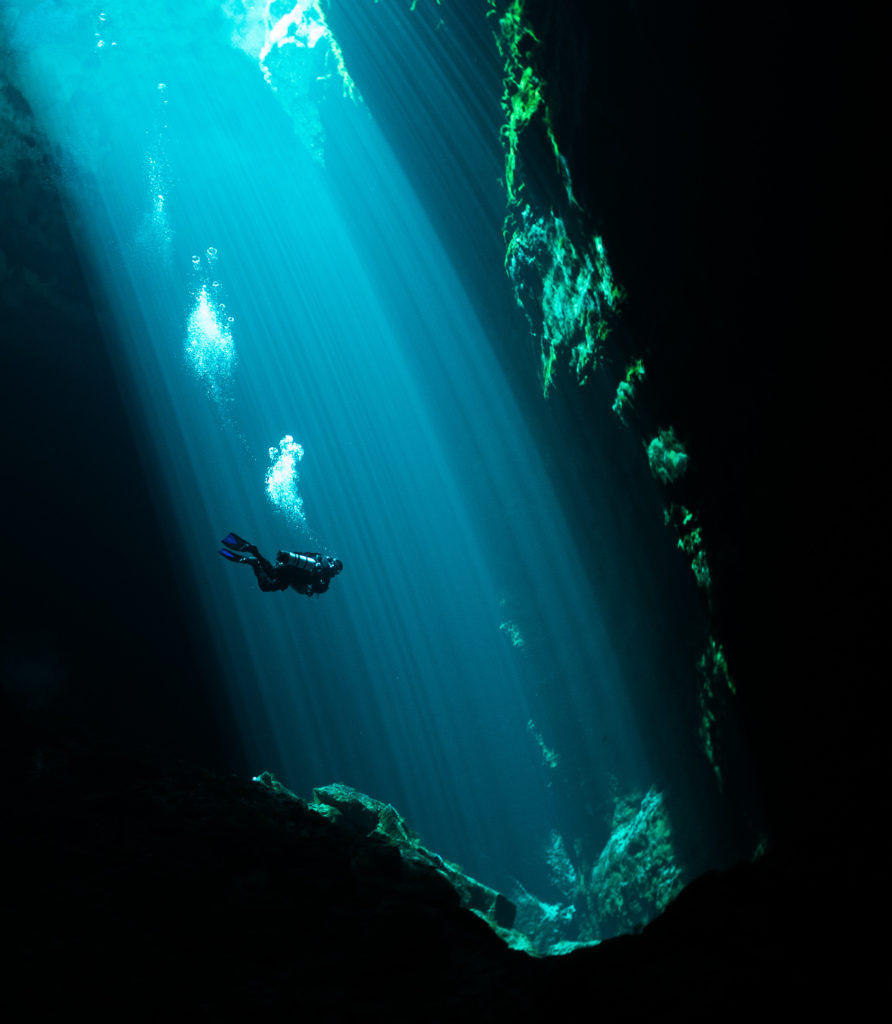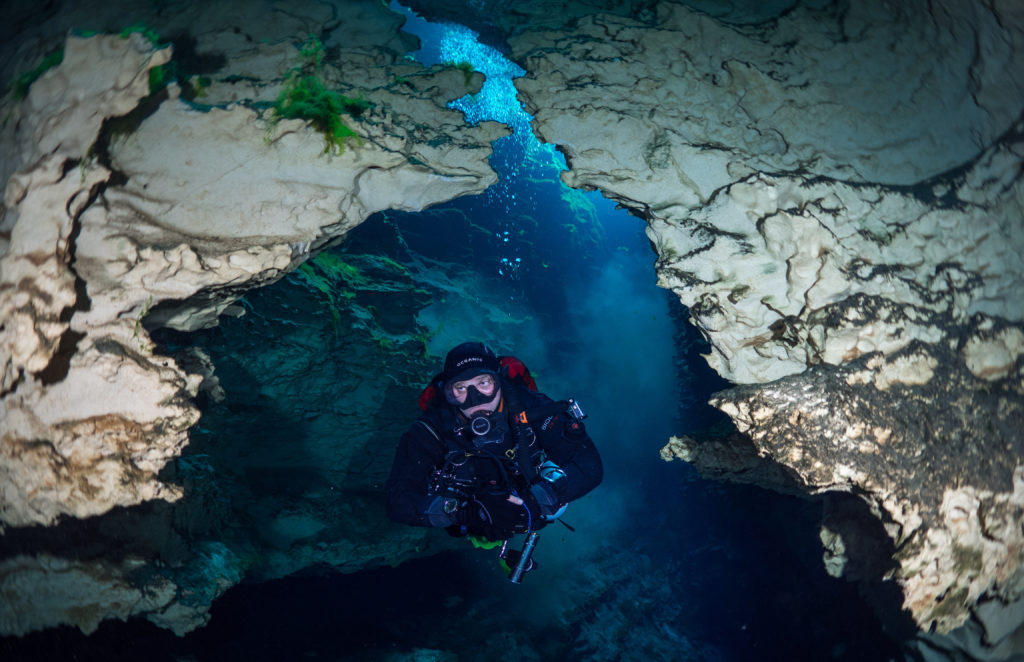Many divers think of cave diving as mysterious or dangerous, best suited to the thrill seekers among us. Truthfully, when executed properly, cave dives are quite safe and extremely exciting. They offer a window into a world few people — divers included — ever see. A sense of exploration fills you as you descend into the waters of a sinkhole or cenote. The first step on the journey to becoming a cave diver is to complete a cavern-diving course. How does it all work and what steps should you take? This answer will change somewhat depending on which agency you choose. The basics below should give you some idea of whether or not cave diving is for you.
Who can become a cave diver?
First, let’s explain the difference between a cavern dive and a cave dive. A cavern dive is conducted in the first part of the cave, where you can look behind you and still see the light source. It becomes a cave dive when you can’t see a light source in any direction. As with any advanced dive course, you must fulfill a number of prerequisites, including a minimum number of logged dives, before you can start your training. Generally speaking, you must first complete your Advanced Open Water course or one in which you become certified to dive to recreational limits of 130 feet (40 m).
You will also need a Cavern certification, or a similar course that shows you’ve got experience in an overhead environment. You must also be an experienced night diver who is confident with low-light methods of communication involving torches. Being qualified or comfortable learning about a twin-tank system, either in the sidemount or backmount configuration is a must. Finally, most agencies require recent dive experience in all the previously mentioned environments. Depending on where you’re diving, you’ll also want a drysuit.
What will I learn?
Depending on your style of diving and certifying agency, the basic skills may range from quite familiar to completely foreign. Cave diving requires divers to use a frog or flutter kick. This method has less chance of stirring up the bottom and therefore reducing visibility. You’ll also learn how to use a line and reel. Learning to lay a line throughout each dive will ensure that you can safely return to the surface. Stress management will teach you how to stay calm and handle multiple dive problems at once, which can create potentially dangerous situations. Out-of-air drills are combined with a lost mask, and torch-failure scenarios allow you to practice dealing with these problems safely and calmly. You’ll learn lots of other, smaller skills along the way as well to help you become a safe and successful cave diver.
What equipment do I need?
There are two ways to carry your tanks into a cave. Although sidemount is currently less popular, it’s growing fast and will likely replace traditional backmount setups in the future. With a tank carried under each arm, alongside your body, and two independent air supplies, what may look awkward on the surface is a very comfortable and versatile system underwater. Sidemount does takes a little getting used to, particularly swapping regulators every so often to ensure equal gas usage.
Traditionally, cave divers have used back-mounted twin tanks. Although they can be prohibitive when trying to squeeze through a small space in an advanced cave, back-mount tanks are more than adequate for most dives. You’ll also need three torches. Buy a specialized cave-style torch for your primary light source. Instead of concentrating on the lumen power, you should check how the beam is focused. A dimmer light with a focused beam will be far more useful in a cave than a bright, wide-beamed video light. Your other torches are backups, and can be any style. Finally, you will need multiple reels. It is best to talk to your instructor before purchasing these, though, to ensure that you’re getting the correct style.
Where can you learn to cavern dive?
While you may be able to complete the skills sections of the course in multiple locations, to really get a feel for the sport you should do your training in a cave-diving area. Not only will you get real experience, but it will also (hopefully) inspire you to continue to the next level. There are multiple cave systems throughout the world, including Mexico’s cenotes in the Yucatan Peninsula, arguably the most popular cave-diving destination in the world. Other well-known spots are northern Florida in the U.S., and Mt. Gambier in Australia.
Cave diving is not for the faint-hearted, and the style of diving does demand a serious and confident approach. While most divers are certainly capable of completing the certification, you must ask yourself why you want to become a cave diver. Decide if you’ve got the discipline required to conduct every dive meticulously, every time. If you’re ready, the magical environments of the world’s caves await.




